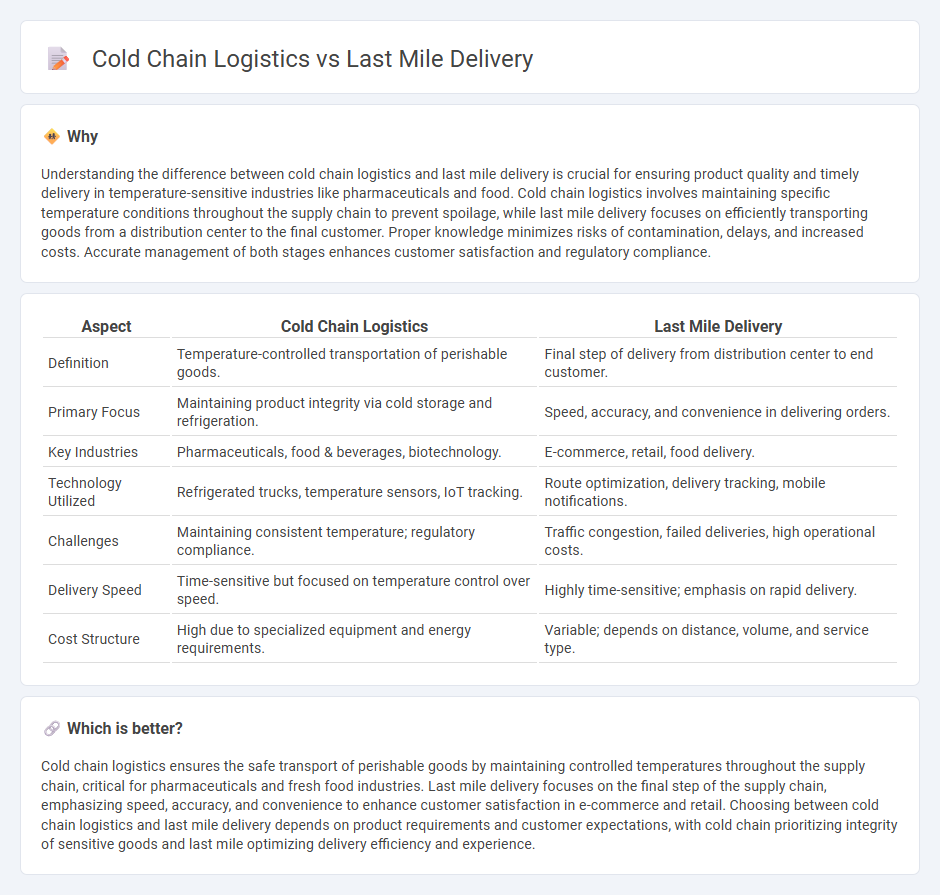
Cold chain logistics ensures temperature-controlled transportation and storage of perishable goods such as pharmaceuticals and fresh food, maintaining product integrity throughout the supply chain. Last mile delivery focuses on the final step of shipping products directly to consumers, emphasizing speed, accuracy, and customer satisfaction. Discover how optimizing both cold chain logistics and last mile delivery can enhance efficiency and reliability in supply chain management.
Why it is important
Understanding the difference between cold chain logistics and last mile delivery is crucial for ensuring product quality and timely delivery in temperature-sensitive industries like pharmaceuticals and food. Cold chain logistics involves maintaining specific temperature conditions throughout the supply chain to prevent spoilage, while last mile delivery focuses on efficiently transporting goods from a distribution center to the final customer. Proper knowledge minimizes risks of contamination, delays, and increased costs. Accurate management of both stages enhances customer satisfaction and regulatory compliance.
Comparison Table
| Aspect | Cold Chain Logistics | Last Mile Delivery |
|---|---|---|
| Definition | Temperature-controlled transportation of perishable goods. | Final step of delivery from distribution center to end customer. |
| Primary Focus | Maintaining product integrity via cold storage and refrigeration. | Speed, accuracy, and convenience in delivering orders. |
| Key Industries | Pharmaceuticals, food & beverages, biotechnology. | E-commerce, retail, food delivery. |
| Technology Utilized | Refrigerated trucks, temperature sensors, IoT tracking. | Route optimization, delivery tracking, mobile notifications. |
| Challenges | Maintaining consistent temperature; regulatory compliance. | Traffic congestion, failed deliveries, high operational costs. |
| Delivery Speed | Time-sensitive but focused on temperature control over speed. | Highly time-sensitive; emphasis on rapid delivery. |
| Cost Structure | High due to specialized equipment and energy requirements. | Variable; depends on distance, volume, and service type. |
Which is better?
Cold chain logistics ensures the safe transport of perishable goods by maintaining controlled temperatures throughout the supply chain, critical for pharmaceuticals and fresh food industries. Last mile delivery focuses on the final step of the supply chain, emphasizing speed, accuracy, and convenience to enhance customer satisfaction in e-commerce and retail. Choosing between cold chain logistics and last mile delivery depends on product requirements and customer expectations, with cold chain prioritizing integrity of sensitive goods and last mile optimizing delivery efficiency and experience.
Connection
Cold chain logistics ensures temperature-sensitive products maintain optimal conditions throughout transportation, which is critical for preserving quality and safety. Last mile delivery plays a vital role in this process by providing timely, controlled environment delivery directly to end customers, reducing spoilage risks. Integrating advanced tracking technology in both stages enhances visibility and ensures compliance with temperature requirements until final delivery.
Key Terms
**Last Mile Delivery:**
Last mile delivery involves the final step of the supply chain, transporting goods from a distribution center to the end consumer, emphasizing speed, efficiency, and real-time tracking. It faces challenges such as urban congestion, delivery precision, and cost control, necessitating advanced route optimization and customer communication technologies. Explore the latest strategies and innovations shaping last mile delivery for enhanced customer satisfaction and operational success.
Route Optimization
Last mile delivery emphasizes swift, efficient routes to ensure rapid parcel arrival, utilizing dynamic route optimization algorithms to reduce transit times and fuel consumption. Cold chain logistics requires precise temperature-controlled route planning to maintain product integrity for perishable goods like pharmaceuticals and fresh produce, balancing speed with environmental constraints. Explore in-depth strategies and technologies driving innovation in route optimization for both logistics domains.
Proof of Delivery
Proof of Delivery (POD) plays a crucial role in last mile delivery by confirming the successful handoff of parcels to end customers, ensuring accountability and customer satisfaction. In cold chain logistics, POD extends beyond basic confirmation, incorporating temperature-sensitive documentation to verify the integrity and compliance of perishable goods throughout transit. Explore how advanced POD solutions optimize both delivery accuracy and temperature compliance for enhanced supply chain efficiency.
Source and External Links
Last mile delivery: solutions for your business | DHL Discover - Last mile delivery is the final leg of the shipment journey from a local distribution center to the customer's doorstep, focused on affordability, speed, and accuracy using vehicles or drop-off points, with innovations like robots and drones emerging.
What is Last-Mile Delivery? Logistics, Costs, and Top Carriers - Last-mile delivery refers to transporting a package from the fulfillment center to the final destination (usually a residence), aiming to balance speed and cost-effectiveness, with tracking crucial for customer satisfaction and costs accounting for a large share of logistics expenses.
Last Mile Delivery Logistics, Trends and Data for Retailers Explained - As the most expensive and time-consuming shipping phase, last-mile delivery is key to customer satisfaction, with benefits including faster delivery, increased convenience, higher sales, and operational efficiencies enabled by technology and new supply chain models.
 dowidth.com
dowidth.com